Regulation of membrane potential and fluid secretion by Ca2+-activated K+ channels in mouse submandibular glands
- PMID: 17379640
- PMCID: PMC2075181
- DOI: 10.1113/jphysiol.2006.127498
Regulation of membrane potential and fluid secretion by Ca2+-activated K+ channels in mouse submandibular glands
Abstract
We have recently shown that the IK1 and maxi-K channels in parotid salivary gland acinar cells are encoded by the K(Ca)3.1 and K(Ca)1.1 genes, respectively, and in vivo stimulated parotid secretion is severely reduced in double-null mice. The current study tested whether submandibular acinar cell function also relies on these channels. We found that the K(+) currents in submandibular acinar cells have the biophysical and pharmacological footprints of IK1 and maxi-K channels and their molecular identities were confirmed by the loss of these currents in K(Ca)3.1- and K(Ca)1.1-null mice. Unexpectedly, the pilocarpine-stimulated in vivo fluid secretion from submandibular glands was essentially normal in double-null mice. This result and the possibility of side-effects of pilocarpine on the nervous system, led us to develop an ex vivo fluid secretion assay. Fluid secretion from the ex vivo assay was substantially (about 75%) reduced in animals with both K(+) channel genes ablated - strongly suggesting systemic complications with the in vivo assay. Additional experiments focusing on the membrane potential in isolated submandibular acinar cells revealed mechanistic details underlying fluid secretion in K(+) channel-deficient mice. The membrane potential of submandibular acinar cells from wild-type mice remained strongly hyperpolarized (-55 +/- 2 mV) relative to the Cl(-) equilibrium potential (-24 mV) during muscarinic stimulation. Similar hyperpolarizations were observed in K(Ca)3.1- and K(Ca)1.1-null mice (-51 +/- 3 and -48 +/- 3 mV, respectively), consistent with the normal fluid secretion produced ex vivo. In contrast, acinar cells from double K(Ca)3.1/K(Ca)1.1-null mice were only slightly hyperpolarized (-35 +/- 2 mV) also consistent with the ex vivo (but not in vivo) results. Finally, we found that the modest hyperpolarization of cells from the double-null mice was maintained by the electrogenic Na(+),K(+)-ATPase.
Figures








Similar articles
-
Apical maxi-K (KCa1.1) channels mediate K+ secretion by the mouse submandibular exocrine gland.Am J Physiol Cell Physiol. 2008 Mar;294(3):C810-9. doi: 10.1152/ajpcell.00511.2007. Epub 2008 Jan 23. Am J Physiol Cell Physiol. 2008. PMID: 18216162 Free PMC article.
-
Molecular identification and physiological roles of parotid acinar cell maxi-K channels.J Biol Chem. 2006 Sep 22;281(38):27964-72. doi: 10.1074/jbc.M603871200. Epub 2006 Jul 27. J Biol Chem. 2006. PMID: 16873365
-
Abolition of Ca2+-mediated intestinal anion secretion and increased stool dehydration in mice lacking the intermediate conductance Ca2+-dependent K+ channel Kcnn4.J Physiol. 2007 Sep 1;583(Pt 2):705-17. doi: 10.1113/jphysiol.2007.134387. Epub 2007 Jun 21. J Physiol. 2007. PMID: 17584847 Free PMC article.
-
Calcium-activated potassium channels and fluid secretion by exocrine glands.Am J Physiol. 1986 Jul;251(1 Pt 1):G1-13. doi: 10.1152/ajpgi.1986.251.1.G1. Am J Physiol. 1986. PMID: 2425634 Review.
-
The receptor-regulated calcium influx in mouse submandibular acinar cells is sodium dependent: a patch-clamp study.J Physiol. 1987 Mar;384:119-30. doi: 10.1113/jphysiol.1987.sp016446. J Physiol. 1987. PMID: 2443656 Free PMC article. Review.
Cited by
-
The role of cell cholesterol and the cytoskeleton in the interaction between IK1 and maxi-K channels.Am J Physiol Cell Physiol. 2009 Apr;296(4):C878-88. doi: 10.1152/ajpcell.00438.2008. Epub 2009 Jan 28. Am J Physiol Cell Physiol. 2009. PMID: 19176762 Free PMC article.
-
Major depression-related factor NEGR1 controls salivary secretion in mouse submandibular glands.iScience. 2023 Apr 26;26(5):106773. doi: 10.1016/j.isci.2023.106773. eCollection 2023 May 19. iScience. 2023. PMID: 37216094 Free PMC article.
-
Ascl3 knockout and cell ablation models reveal complexity of salivary gland maintenance and regeneration.Dev Biol. 2011 May 15;353(2):186-93. doi: 10.1016/j.ydbio.2011.02.025. Epub 2011 Mar 4. Dev Biol. 2011. PMID: 21377457 Free PMC article.
-
Loss of Fam20c causes defects in the acinar and duct structure of salivary glands in mice.Int J Mol Med. 2019 May;43(5):2103-2117. doi: 10.3892/ijmm.2019.4126. Epub 2019 Mar 6. Int J Mol Med. 2019. PMID: 30864688 Free PMC article.
-
Regulation of BK Channels by Beta and Gamma Subunits.Annu Rev Physiol. 2019 Feb 10;81:113-137. doi: 10.1146/annurev-physiol-022516-034038. Annu Rev Physiol. 2019. PMID: 30742788 Free PMC article. Review.
References
-
- Begenisich T, Nakamoto T, Ovitt CE, Nehrke K, Brugnara C, Alper SL, Melvin JE. Physiological roles of the intermediate conductance, Ca2+-activated potassium channel Kcnn4. J Biol Chem. 2004;279:47681–47687. - PubMed
-
- Bruce JI, Shuttleworth TJ, Giovannucci DR, Yule DI. Phosphorylation of inositol 1,4,5-trisphosphate receptors in parotid acinar cells. A mechanism for the synergistic effects of cAMP on Ca2+ signaling. J Biol Chem. 2002;277:1340–1348. - PubMed
-
- Bymaster FP, Carter PA, Yamada M, Gomeza J, Wess J, Hamilton SE, Nathanson NM, McKinzie DL, Felder CC. Role of specific muscarinic receptor subtypes in cholinergic parasympathomimetic responses, in vivo phosphoinositide hydrolysis, and pilocarpine-induced seizure activity. Eur J Neurosci. 2003;17:1403–1410. - PubMed
-
- Cecanho R, Anaya M, Renzi A, Menani JV, De Luca LA., Jr Sympathetic mediation of salivation induced by intracerebroventricular pilocarpine in rats. J Auton Nerv Syst. 1999;76:9–14. - PubMed
-
- Cook DI, Van Lennep EW, Roberts ML, Young JA. Secretion by the Major Salivary Glands. New York: Raven Press; 1994.
Publication types
MeSH terms
Substances
Grants and funding
LinkOut - more resources
Full Text Sources
Medical
Molecular Biology Databases
Miscellaneous

